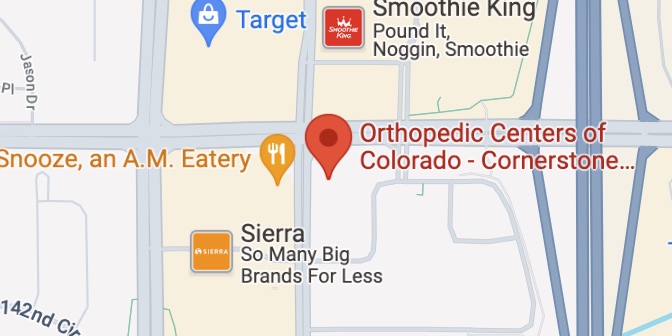Shockwave Therapy
Shockwave Thearpy
A Non-Surgical Solution for Chronic Pain
If you’re struggling with ongoing joint or tendon pain that hasn’t improved with rest, physical therapy, or medication, shockwave therapy may be the relief you’ve been looking for.
At Orthopedic Centers of Colorado, we offer non-invasive shockwave therapy to help treat a variety of chronic musculoskeletal conditions—without the need for injections or surgery.
What Is Shockwave Therapy?
Shockwave therapy (also known as Extracorporeal Shockwave Therapy or ESWT) uses high-energy sound waves to stimulate your body’s natural healing response. These waves target damaged tissue, increasing blood flow and encouraging tissue regeneration—helping to reduce pain and promote faster recovery.
Conditions Treated with Shockwave Therapy
Shockwave therapy is especially effective for treating chronic conditions that involve inflammation, tendon damage, or overuse. Common conditions include:
Tendinopathies:
- Plantar fasciitis (including heel spurs)
- Achilles tendinopathy
- Patellar tendinopathy (jumper’s knee)
- Gluteal tendinopathy
- Rotator cuff tendinopathy (particularly calcific tendonitis of the shoulder)
- Tennis elbow (lateral epicondylitis)
- Golfer’s elbow (medial epicondylitis)
- And more…
Chronic Soft Tissue Pain:
- Myofascial trigger points
- Hamstring or groin pain
- Shin splints
Other Orthopedic Uses:
- Non-healing fractures or stress fractures (to stimulate bone healing)
- Calcific deposits in tendons
- Scar tissue and post-surgical adhesions
Why Shockwave Therapy Is Used:
- Non-invasive – No needles, no downtime
- Fast treatment sessions – Usually under 30 minutes
- Long-lasting relief – Stimulates the body’s own healing process
- Minimal side effects – Safe and well-tolerated for most patients
Is Shockwave Therapy Right for You?
Shockwave therapy is ideal for patients dealing with chronic pain that hasn’t improved with other conservative treatments. Our orthopedic specialists will evaluate your condition and help determine if this treatment is right for you.
Get Back to What You Love – Pain-Free
Don’t let chronic pain keep you from doing what you love. Contact us today to learn more about shockwave therapy or to schedule a consultation with one of our experienced orthopedic providers.

Frequently Asked Questions
What is shockwave?
Extracorporeal Shockwave Therapy (ESWT) is an FDA-cleared, non-invasive treatment performed right in the office. This highly effective therapy uses acoustic pressure waves to reduce pain and stimulate the body’s natural healing and tissue repair processes. It’s commonly used to treat a wide range of chronic musculoskeletal conditions without the need for surgery or injections.
What conditions can be treated by shockwave?
Shockwave therapy is an effective treatment for a variety of musculoskeletal conditions affecting the tendons, muscles, bones, and joints. It’s commonly used to treat plantar fasciitis, tendinopathies (such as Achilles, patellar, hamstring, elbow, and shoulder), bone injuries (including stress fractures and non-healing fractures), and joint-related injuries.
What are the advantages of shockwave?
Shockwave therapy is a non-invasive, outpatient treatment with a strong safety profile and minimal reported complications in clinical studies. Backed by evidence-based research, it has proven effective for many common musculoskeletal conditions. Our providers have extensive experience using shockwave therapy and follow best practices rooted in science to help patients achieve optimal results.
What is the difference between radial and focused shockwave?
At OCC, we offer both focused and radial shockwave therapy, each designed to target different types and depths of musculoskeletal tissue.
Focused shockwave therapy uses advanced electromagnetic technology to deliver high-energy waves that penetrate deeper into the tissue. This makes it especially effective for treating bone and joint conditions. It can also be combined with radial shockwave to address tendon and fascia-related issues.
Radial shockwave therapy is generated using a pneumatic, air-pressured device that creates lower-energy waves. These waves are ideal for treating more superficial structures, such as tendons and fascia. This method, also known as Extracorporeal Pulse Activation Technology (EPAT), is often used as a first-line treatment or in combination with focused shockwave for enhanced results.
Your OCC physician will determine the most appropriate approach—focused, radial, or a combination—based on your clinical history, condition, and treatment goals.
Does the treatment hurt?
Some discomfort during treatment is normal and helps guide the therapy. Your provider will work to keep the pain level tolerable, as the treatment is focused specifically on the injured tissue.
How many treatments will I need?
The number of shockwave therapy sessions varies depending on your condition, typically ranging from 3 to 6 treatments spaced about one week apart (no sooner than 3 days and no longer than 10 days between sessions). Each session lasts approximately 10 to 20 minutes. While some patients experience pain relief after the first treatment, full healing effects may take up to 12 weeks from the start of therapy.
How often will I need the treatment?
Shockwave therapy is typically administered once per week.
After completing 3 to 4 sessions, you’ll be scheduled for a follow-up visit in 6 to 8 weeks to evaluate your response to treatment. Based on your progress, your physician may recommend additional sessions to help you achieve the best possible outcome.
Research shows that most patients experience optimal improvement with up to 6 sessions. While many patients see meaningful pain relief and improved function, some may not reach their desired results. In those cases, your physician may discuss alternative treatment options to better support your recovery goals.
Will I feel any pain after the treatment?
After treatment, it’s normal to experience temporary soreness, tenderness, or mild swelling for a few days. This is part of the body’s natural healing response triggered by shockwave therapy.
To support this healing process, it’s recommended to avoid anti-inflammatory medications such as Advil, Aleve, Ibuprofen, or oral steroids during your treatment cycle. Instead, you may use Tylenol and ice to help manage any discomfort.
Are there any restrictions after the treatment?
Your physician will advise you on which activities to avoid during your recovery. For soft tissue injuries, most normal activities can typically be resumed after 48 hours. However, for bone-related injuries, activity restrictions may last longer to ensure proper healing.
What activities can I do to help the treatment?
The goal of shockwave therapy is to reduce pain and restore long-term function. To enhance results, your physician may recommend a combination of physical therapy and a personalized home exercise program. These activities help reinforce healthy movement patterns and support tissue healing.
Your return to sports or physical activity will be guided by your physician based on your progress. Shockwave therapy works best when paired with gradual movement retraining, helping you safely return to activity while promoting lasting recovery.
Shockwave Therapy Specialists
Shockwave Therapy Clinic Locations



